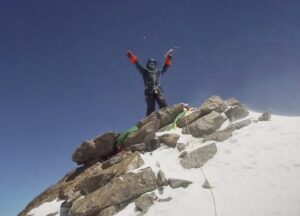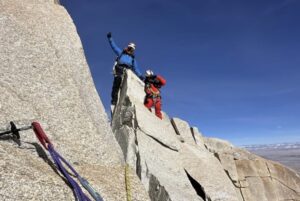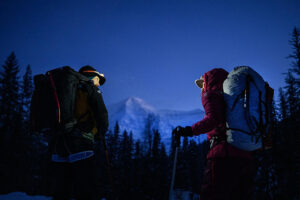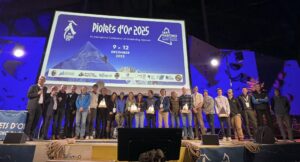Climbing skills go beyond the obvious. There is technique and power, both physical and mental, but you also need to adapt to changing conditions. You must make tricky choices in the face of the unknown, and as Slovenian climber Matija Volontar notes, “look up and check what is around you.”
That’s how Volontar, Bor Levicnik, and Ziga Orazem ended up bagging a beautiful first ascent on a Solokhumbu 6,000’er. Straight after arriving back in Kathmandu, Volontar shared details of their ascent with ExplorersWeb.
Last year, Volontar had a bittersweet experience on Rolwaling’s Chobutse. He teamed up with star climber Marko Prezelj to attempt a new line on the south face. Meanwhile, team members Luka Strazar and Nejc Marcic tried another route up the west face. Strazar and Marcic succeeded, but Volontar and Prezelj had to retreat in high winds.

A rocky section of the route. Photo: Matija Volontar
A change of plans
For fall 2022, Volontar thoroughly researched his options. Finally, he opted for Tengi Ragi Tau, an almost 7,000m peak near Thame village in the Khumbu. He persuaded Bor Levicnik and Ziga Orazem to join him.
But while acclimatizing, they looked around and spotted another interesting option: Pomlaca. A little-known 6,180m peak, Pomlaca is also called Ngole East. Villagers assured the climbers that it had never been summited.
How surprising is it to find an unclimbed peak in the popular Khumbu valley? Why hadn’t Pomlaca been scaled before?
“The first reason is, Pomlaca is in the shadow of much bigger peaks,” Volontar said.
“The second reason is that it is hard to find a way to reach the face. We searched for five hours to find a way among the seracs. Then we climbed two pitches of grade-V rock before reaching a big, flat glacier plateau at some 5,300m. This led smoothly to the face.”
Climbing pure alpine style
Well-acclimatized, they climbed in a single, extremely fast push. “We made it to the top in under nine hours, although the face was steeper than we had expected. It was between 70º and 90º all the time, with some multi-pitch sections at 90º,” Volontar said.
“Overall, conditions on the route were really very good. Except for maybe 50m, the whole line was ice or hard snow.”

A section of near-vertical ice. Photo: Matija Volontar
They had good reason to climb fast: “We didn’t belay much. Well, we did belay, but we only had one rope for the three of us, which makes the climb much faster and much easier to handle the rope.”
The three climbers are highly experienced and have climbed together before, both at home in the Slovenian mountains and in South America. In addition, all once belonged to the Slovenian Youth Alpine Team.
They descended the east ridge, facing the opposite side of the mountain.
“The peak itself is like a snowy spike, with a very narrow ridge to the top. But the east ridge is easier, especially on the upper part. It is mellow glacier terrain,” Volontar explained.
“The second part is some grade-III rock that we just downclimbed. We only used the rope for the final 20m.”
The team then returned to their base, which was not a camp, but a lodge in Thyangbo village.
In the end, the team climbed a 1,100m route that they graded as AI5/70-90º/IV-V. They named it the “Screaming Barfies”. For those not familiar with the term, Volontar explained: “It’s that feeling you get in your fingers when the blood starts circulating after being numb from cold for a while. It hurts like hell!”

On the summit. Photo: Ziga Orazem
Looking up for treasures
Volontar insists that, despite having climbed a virgin peak, theirs was not exploratory alpinism in the strict sense. “If you want to have a pure exploratory adventure, Solokhumbu is not the place to go,” he conceded. “Once you step off the mountain, you find yourself in the middle of the crowds.
“On the other hand, what we wanted was to be able to focus on the climb without bothering with expedition logistics. That is why we chose this region. Yet, the fact that we found and climbed a virgin peak is proof that there’s still a lot to do, even in popular areas.”
Volontar even has a suggestion for those interested in following their trail: “Pomlaca’s neighboring peak is also unclimbed, and 700m higher.”
“Being in the vicinity of bigger peaks, people just keep their eyes on the ground and do not look around. Or they don’t dare to try,” Volontar says. “In our case, we renounced our primary goal, for which we had planned and prepared for months, and completely refocused on a new mountain. We basically put it all on the line and went for it. That’s the game we played.”

The “Screaming Barfies” route. Photo: Matija Volontar
“We all agree it was the right call. We knew everything about Tengi Rangi Tau. By comparison, taking on a face we knew absolutely nothing about brought a new edge to the climb.”
Back in Kathmandu, the team had an interview with The Himalayan Database team, who confirmed the peak was indeed previously unclimbed.
UPDATE: Five days after this story was posted, Matija Volontar contacted ExplorersWeb to point out that they learned that their climb on Pomlaca was actually not a first ascent. “We were the first to climb the West Face to the top, but another French team in 2005 previously climbed the mountain,” he said.






